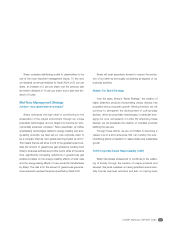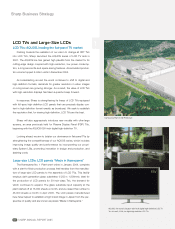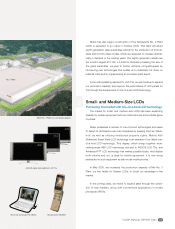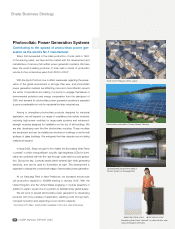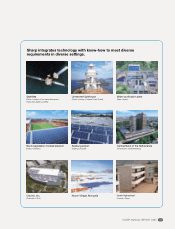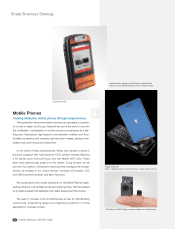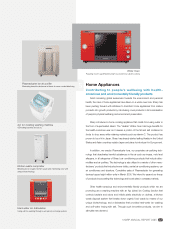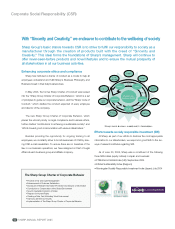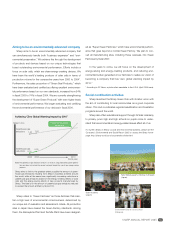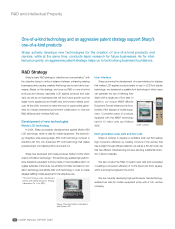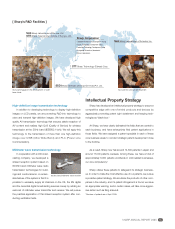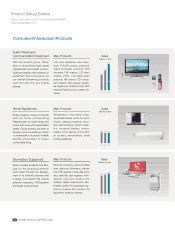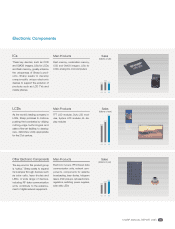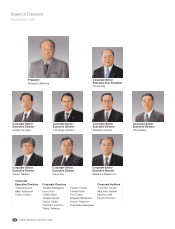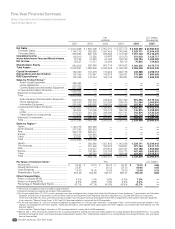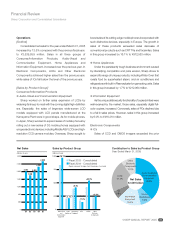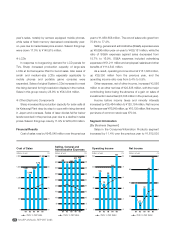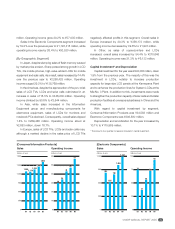Sharp 2005 Annual Report Download - page 19
Download and view the complete annual report
Please find page 19 of the 2005 Sharp annual report below. You can navigate through the pages in the report by either clicking on the pages listed below, or by using the keyword search tool below to find specific information within the annual report.
SHARP ANNUAL REPORT 2005 14
Aiming to be an environmentally advanced company
Sharp aims to be an environmentally advanced company that
can simultaneously handle both “business expansion” and “envi-
ronmental preservation.” We achieve this through the development
of products and devices based on our unique technologies that
boast outstanding environmental performance. Efforts include a
focus on solar cells, which are clean-energy-creating devices. We
have been the world’s leading producer of solar cells in terms of
production volume for five consecutive years from 2000 to 2004*.
Furthermore, the sales proportion of “Green Seal Products,” which
have been evaluated and certified as offering excellent environmen-
tal performance based on our own standards, increased from 54%
in fiscal 2003 to 74% in fiscal 2004. We are currently strengthening
the development of “Super Green Products” with even higher levels
of environmental performance. We began evaluating and certifying
the environmental performance of our devices in fiscal 2004.
Sharp refers to “Green Factories” as those factories that main-
tain a high level of environmental consciousness, determined by
our unique set of evaluation and assessment criteria. All production
sites in Japan have cleared the Green Factory standards. Among
them, the Kameyama Plant and the Mie Plant have been designat-
ed as “Super Green Factories,” which have environmental perform-
ance that goes beyond a normal Green Factory. We plan to con-
vert all manufacturing sites, including those overseas, into Green
Factories by fiscal 2007.
In the years to come, we will focus on the development of
energy-saving and energy-creating products, and reducing envi-
ronmental burden generated at our factories to realize our vision of
becoming a company that has “zero global warming impact by
2010.”
* According to PV News, a photovoltaic newsletter in the U.S.A. (April 2005 issue)
Social contribution activities
Sharp launched the Sharp Green Club with its labor union with
the aim of contributing to local communities as a good corporate
citizen. This club coordinates regional beautification and forestation
programs around the world.
Sharp also offers educational support through its Solar Academy
to primary, junior high and high schools so pupils come to under-
stand that environmental and energy-related issues affect all of us.
Solar Academy
(Japan)
Nara Wakakusayama Cleanup Campaign
(Japan)
Environment Day at a local school
(Malaysia)
For further details on Sharp’s social and environmental activities, please see the
Company’s Environmental and Social Report 2005 or access the Sharp home-
page: http://sharp-world.com/corporate/eco/index.html
2003 2004 2010
0.14
1.44 1.51
0.24
(fiscal year)
Greenhouse gas
reductions
Greenhouse gas
emissions
Million t-CO2Reductions surpass
emissions
Sharp aims to limit to the greatest extent possible the amount of green-
house gas emissions resulting from Sharp’s business activities around
the world, while at the same time, significantly increasing reductions in
greenhouse gas emissions based on the energy-creating effects of solar
cells and the energy-saving effects of new products manufactured by
Sharp. The idea is for the amount of greenhouse gas emissions reduced
to exceed the amount emitted by fiscal 2010.
Achieving “Zero Global Warming Impact by 2010”
(Note) The greenhouse gas reduction amount is a result of using photovoltaic power genera-
tion and does not include the amount reduced though the use of new energy-saving
products.


